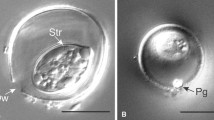Abstract
During a survey of Guatemalan herpetofauna in the summers of 1998–2000, 29 presumed new species of Eimeria Schneider, 1875 were found, seven of which have a distinct elongate-ellipsoidal shape (L/W ratio ≥ 1.7) and are described herein. Six of the seven new species are similar in oöcyst length, width and L/W ratio and sporocyst length, width and L/W ratio, lack a micropyle, oöcyst residuum, Stieda body, sub- and parastieda bodies, have a polar granule and sporocyst residuum, and their sporocysts appear to have dehiscence sutures. The seventh is slightly smaller and has sporocysts with a Stieda body. The new species are: E. coniophanes n. sp – whose sporulated oöcysts from Coniophanes fissidens are 29.2×14.9 (27–31×13–16) \(\upmu\)m, with sporocysts \(10.0\times7.8 \ \upmu\)m; E. coniophis n. sp. –from Conophis lineatus are 32.0×16.5 (30–34×14–18) \(\upmu\)m, with sporocysts \(10.2\times8.9\upmu\)m; E. dryomarchoni n. sp. – from Drymarchon corais are 32.2×17.7 (31–34×17–19) \(\upmu\)m, with sporocysts \(10.7\times8.6 \ \upmu\)m; E. leptophis n. sp. – from Leptophis mexicanus are 29.5×17.0 (28–31×16–18) \(\upmu\)m, with sporocysts \(10.0\times9.1 \ \upmu\)m; E. oxybelis n. sp. – from Oxybelis aeneus are 31.8×16.5 (29–33×15–18) \(\upmu\)m, with sporocysts \(10.3\times8.8 \ \upmu\)m; and E. scaphiodontophis n. sp. – from Scaphiodontophis annulatus are 30.0×15.3 (28–33×14–16) \(\upmu\)m, with sporocysts \(9.9\times7.9 \ \upmu\)m. Sporulated oöcysts of E. siboni n. sp. from Sibon nebulata are 24.3×14.2 (21–27×13–16) \(\upmu\)m, with sporocysts \(10.0\times7.1 \ \upmu\)m and with a Stieda body. We conclude that until all aspects of each life-cycle are known, it is prudent at this time to name all tetrasporocystic dizoic coccidia from snakes as members of Eimeria rather than place some of them in Choleoeimeria Paperna & Landsberg, 1989.
Similar content being viewed by others
References
Anderson D.R., Duszynski D.W., Marquardt W.C. (1968) Three new coccidia (Protozoa: Telosporea) from kingsnakes, Lampropeltis spp., in Illinois, with a description of Eimeria zamensi Phisalix, 1921. Journal of Parasitology 54: 577–581
Debaisieux P. (1914) Recherches sur les coccidies IV. Eimeria cystis-felleae, nov. spec. La Cellule 29: 433–449
Duszynski D.W., Wilber P.G. (1997) A guideline for the preparation of species descriptions in the Eimeriidae. Journal of Parasitology 83: 333–336
Dyková I., Lom J. (1981) Fish coccidia: critical notes on life cycles, classification and pathogenicity. Journal of Fish Disease 4: 487–505
Frey J.K., Yates T.L., Duszynski D.W., Gannon W.L., Gardner S.L. (1992) Designation and curatorial management of type host specimens (symbiotype) for new parasite species. Journal of Parasitology 78: 930–932
Gardiner C.H., Imes G.D., Jacobson E.R., Foggin C.M. (1986) Sporulated coccidian oöcysts resembling Goussia Labbé, 1896, in viscera of Nile crocodiles. Journal of Wildlife Disease 22: 575–577
Guyenot E., Naville A., Ponse K. (1922) Deux coccidies parasites de Tropidonotus natrix, Eimeria cystis felleae, et E. tropidonoti n. sp. Revue Suisse Zoologie 30: 115–157
Iskander A.R., Tadros G. (1979) Eimeria samiae sp. nov. (Eimeriidae: Sporozoa) from the snake Python reticulata and its pathogenicity in the intestine. Bulletin of the Zoological Society of Egypt 29: 66–71
Jirku M., Modry D., Slapeta J.R., Koudela B., Lukes J. (2002) The phylogeny of Goussia and Choleoeimeria (Apicomplexa: Eimeriorina) and the evolution of excystation structures in coccidia. Protist 153: 379–390
Levine N.D. (1983) The genera Barrouxia, Defretinella, and Goussia of the coccidian family Barrouxiidae (Protozoa, Apicomplexa). Journal of Protozoology 30: 542–547
Molnár K., (1995) Redescription of Goussia neglecta n. comb. (Nöller, 1920) (Apicomplexa: Coccidia) and notes on its occurrence in the gut of tadpoles. Acta Veterinaria Hungarica 43: 269–275
Morrison D.A., Bornstein S., Thebo P., Wernery U., Kinne J., Mattsson J.G. (2004) The current status of the small subunit rRNA phylogeny of the coccidia (Sporozoa). International Journal for Parasitology 34: 501–514
Paperna I., Lainson R. (2000) Ultrastructural study of meronts and gamonts of Choleoeimeria rochalimai (Apicomplexa: Eimeriidae) developing in the gall bladder of the gecko Hemidactylus mabouia from Brazil. Folia Parasitologica 47: 91–96
Paperna I., Landsberg H. (1989) Description and taxonomic discussion of eimerian coccidia from African and Levantine geckoes. South African Journal of Zoology 24: 345–355
Paperna I., Ogara W., Schein M. (1997) Goussia hyperolisi n. sp.: a coccidian infection in reed frog Hyperolis viridiflavus tadpoles which expires towards metamorphosis. Diseases of Aquatic Organisms 31: 79–88
Pellérdy L.P. (1974) Coccidia and coccidiosis. (2nd ed.). Paul Parey, Berlin, 959 pp.
Pinto C. (1928) Eimeria amarali n. sp. parasita de Bothrops neuwiedii, ophideo do Brazil. Boletim Biologico 11: 11–12
Ray H., Das Gupta M. (1936) On an Eimeria from Naja naja. Proceedings of the Indian Science Congress 23: 345–346
Slapeta J.R., Modry M., Votypka J., Jirku M., Obornik M., Lukes J., Koudela B. (2001) Eimeria telekii n.sp. (Apicomplexa: Coccidia) from Lemniscomys striatus (Rodentia: Muridae): morphology, pathology and phylogeny. Parasitology 122: 133–143
Uetz P. (2003) EMBL reptile database. http://www.embl- heidelberg.de/∼ ∼uetz/db-info/SpeciesStat.html
Upton S.J., McAllister C.T. (1988) Three new species of Eimeria (Apicomplexa: Eimeriidae) from Nerodia rhombifera (Serpentes: Colubridae) from Texas. Journal of Protozoology 35: 511–513
Van Peenan P.F.D., Birdwell T.L. (1968) Coccidian parasites of the California banded king snake, Lampropeltis getulus californiae. Parasitology 58: 349–354
Van Peenen P.F.D., Ryan P.F., McIntyre T.J. (1967) Eimeria korros and E. modesta spp. n. (Protozoa: Eimeriidae) from a snake and a tree shrew in South Vietnam. Journal of Parasitology 53: 1148–1150
Wilber P.G., Duszynski D.W., Upton S.J., Seville R.S., Corliss J.O. (1998) A revision of the taxonomy and nomenclature of the Eimeria spp. (Appicomplexa: Eimeriidae) from rodents in the tribe Marmotini (Sciuridae). Systematic Parasitology 39: 113–135
Acknowledgments
This work was supported by Survey and Inventory grants (NSF, DEB 9705277, 0102383) to J.A. Campbell, by a PEET grant (NSF, DEB 9521687) to D.W. Duszynski, and a Survey and Inventory grant (NSF, DEB 9505025) to D.W. Duszynski.
Author information
Authors and Affiliations
Corresponding author
Rights and permissions
About this article
Cite this article
Asmundsson, I.M., Duszynski, D.W. & Campbell, J.A. Seven new species of Eimeria Schneider, 1875 (Apicomplexa: Eimeriidae) from colubrid snakes of Guatemala and a discussion of what to call ellipsoid tetrasporocystic, dizoic coccidia of reptiles. Syst Parasitol 64, 91–103 (2006). https://doi.org/10.1007/s11230-005-9022-6
Received:
Accepted:
Published:
Issue Date:
DOI: https://doi.org/10.1007/s11230-005-9022-6




